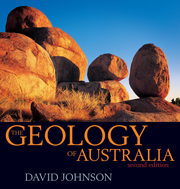Book contents
- Frontmatter
- Contents
- Map
- Preface
- Acknowledgements
- Map of main localities mentioned
- Abbreviations and units
- 1 An Australian perspective
- 2 The Earth: A geology primer
- 3 Building the core of Precambrian rocks
- 4 Warm times: Tropical corals and arid lands
- 5 Icehouse: Carboniferous and Permian glaciation
- 6 Mesozoic warming: The great inland plains and seas
- 7 Birth of modern Australia: Flowering plants, mammals and deserts
- 8 The history and evolution of life on Earth
- 9 Eastern highlands and volcanoes barely extinct
- 10 Building the continental shelf and coastlines
- 11 Great Barrier Reef
- 12 Planets, moons, meteorites and impact craters
- 13 A geological perspective on climate change
- 14 Cycles in a continental journey
- Sources and references
- Figure sources
- Index
8 - The history and evolution of life on Earth
Published online by Cambridge University Press: 05 August 2013
- Frontmatter
- Contents
- Map
- Preface
- Acknowledgements
- Map of main localities mentioned
- Abbreviations and units
- 1 An Australian perspective
- 2 The Earth: A geology primer
- 3 Building the core of Precambrian rocks
- 4 Warm times: Tropical corals and arid lands
- 5 Icehouse: Carboniferous and Permian glaciation
- 6 Mesozoic warming: The great inland plains and seas
- 7 Birth of modern Australia: Flowering plants, mammals and deserts
- 8 The history and evolution of life on Earth
- 9 Eastern highlands and volcanoes barely extinct
- 10 Building the continental shelf and coastlines
- 11 Great Barrier Reef
- 12 Planets, moons, meteorites and impact craters
- 13 A geological perspective on climate change
- 14 Cycles in a continental journey
- Sources and references
- Figure sources
- Index
Summary
Australian fossils provide an almost complete record of life from the earliest stromatolites to modern mammals. How old are the first shells and corals, and how old the first land plants? What does this record tell us about the evolution of life on Earth and how Australia came to have its very distinctive fauna and flora?
FOSSILS
Fossils are remnants of ancient life found in sedimentary rocks, and are so called from the Latin fossilis, which means ‘dug up’ or ‘dug out’. The fossil record in ancient rocks is a record of life and evolution on Earth over thousands of millions of years.
A fossil is most commonly the hard part of a plant or animal, such as shell or bone, which can also be replaced by another mineral, such as opalised wood (see Box 8.1). A fossil may also be simply the impression made when the item rested in soft sediment which has then been hardened into rock. In rare cases the fossil can consist of the preserved tissues of an organism, as when encased in amber, ice, or pitch. Finally, we also refer to trace fossils – that is the tracks or trails left by an organism moving across or burrowing into soft sediment that has then been turned into rock.
- Type
- Chapter
- Information
- The Geology of Australia , pp. 167 - 188Publisher: Cambridge University PressPrint publication year: 2009



